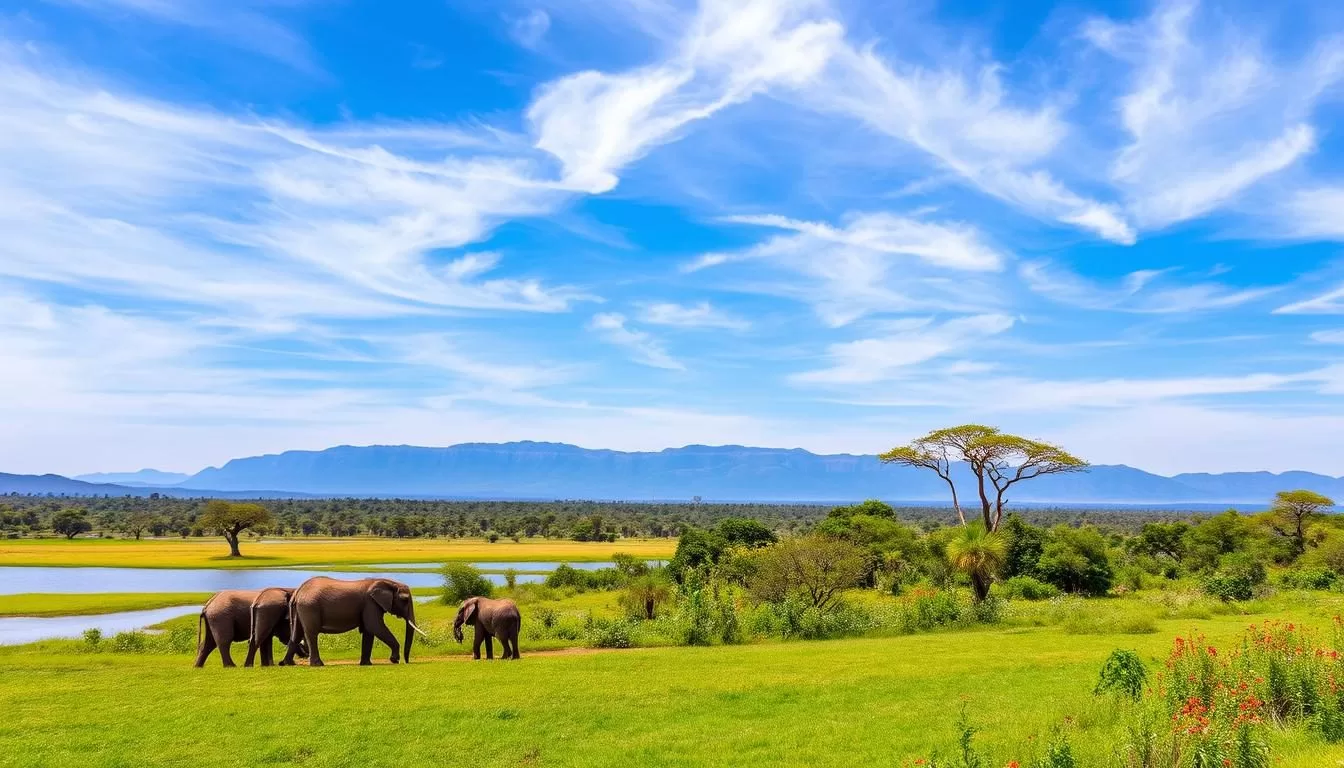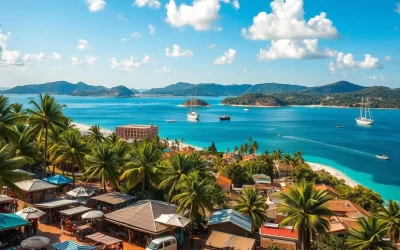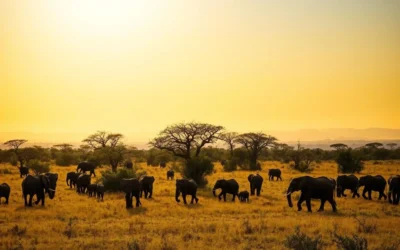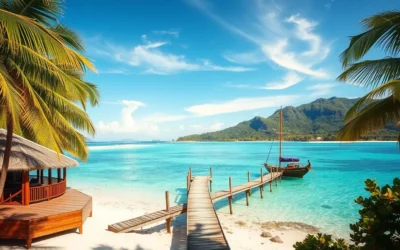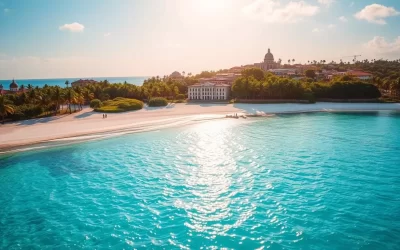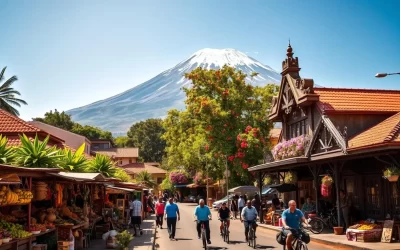✓ Accommodations ✓ Flights ✓ Rental Cars
You’re about to explore one of Tanzania’s most fascinating national parks. Lake Manyara National Park is renowned for its diverse landscapes and incredible wildlife viewing opportunities.
Despite its relatively small size, the park offers a unique safari experience, with tree-climbing lions, large elephant herds, and over 400 species of birds. The diverse ecosystems, including groundwater forests, open savannahs, and acacia woodlands, make it an ideal destination for nature lovers.
As you visit, you’ll have the chance to see four of the Big Five animals, and the park serves as an excellent starting point for a Northern Circuit safari that might also include visits to the Serengeti and Ngorongoro Crater.
Discovering Lake Manyara National Park
Lake Manyara National Park, with its captivating history and varied landscapes, is an ideal location for exploring the heart of Tanzania’s natural beauty. As you delve into the park’s story, you’ll uncover the layers that make it a unique destination.
The Rich History of Lake Manyara
The name ‘Lake Manyara’ originates from the Masai word ‘Emanyara’, a plant used for building houses, fences, and enclosures. Lake Manyara National Park has a rich history, having been used as hunting grounds from 1920 before being secured as a National Park in 1960 to conserve its ecosystem.
The park’s evolution continued in 1974 when it was expanded to cover more than 5 square kilometers in the southern area. This expansion enhanced wildlife protection efforts, making it a significant sanctuary for various species.
What Makes Lake Manyara Special
Lake Manyara National Park is truly special due to its remarkable concentration of diverse habitats in a compact area. This allows visitors to experience multiple ecosystems in a single day’s safari.
| Feature | Description | Benefit |
|---|---|---|
| Diverse Habitats | Varied landscapes including forests, grasslands, and the lake | Experience multiple ecosystems in one day |
| Rich Wildlife | Home to a wide range of animals, including tree-climbing lions | Opportunity to spot diverse wildlife |
| Historical Significance | Protected since 1960, with a history dating back to the 1920s | Understand the conservation efforts |
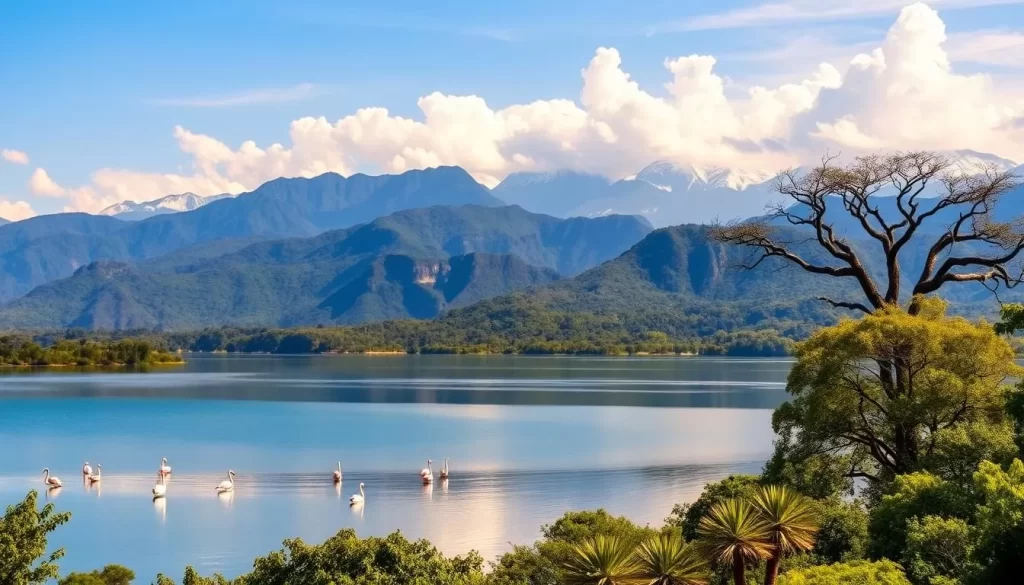
Where Is Lake Manyara National Park Located?
Tanzania’s Lake Manyara National Park is situated in a remarkable geographical setting, between the Great Rift Valley and the lake itself. This unique location in northern Tanzania contributes to the park’s diverse ecosystems and rich biodiversity.
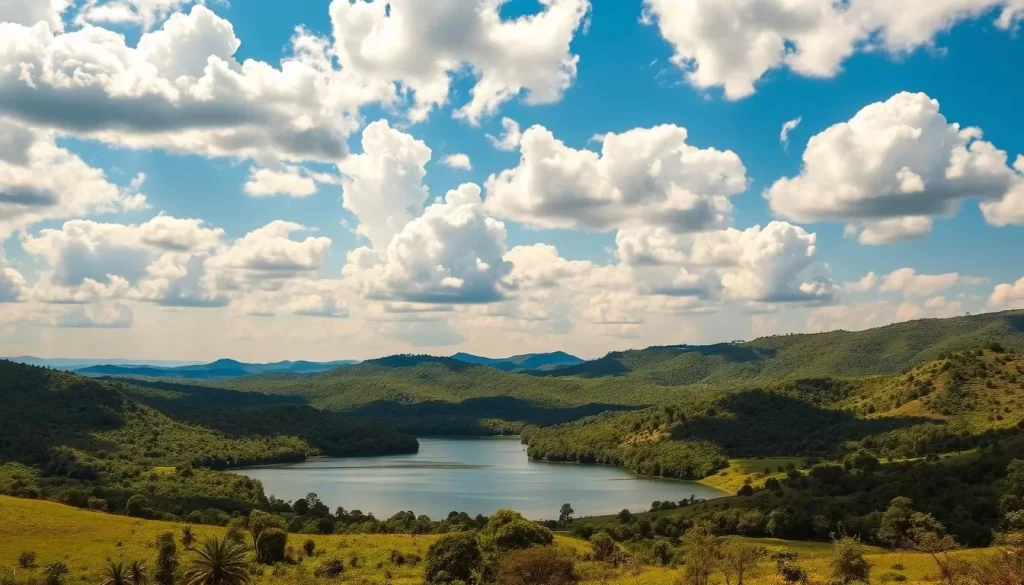
Lake Manyara on Tanzania’s Northern Safari Circuit
Lake Manyara National Park is conveniently located just 126 km from Arusha, making it one of the most accessible parks on Tanzania’s famous Northern Safari Circuit. The park is strategically positioned as a gateway to other renowned parks, often serving as the first stop on the Northern Circuit route. When planning your Tanzania safari itinerary, you’ll appreciate the ease of visiting Lake Manyara along with other nearby attractions.
Distances to Neighboring Parks
The park’s proximity to other notable destinations makes it an ideal starting point for your safari adventure. Here are the distances from Lake Manyara to neighboring parks:
| Park | Distance from Lake Manyara |
|---|---|
| Serengeti National Park | 200 km |
| Ngorongoro Crater | 75 km |
| Tarangire National Park | 65 km |
| Lake Eyasi | 80 km |
These neighboring parks offer a variety of experiences, from the vast plains of the Serengeti to the unique landscapes of the Ngorongoro Crater. By visiting Lake Manyara National Park, you’re well-positioned to explore the best of Tanzania’s northern safari circuit.
How to Get to Lake Manyara National Park
Reaching Lake Manyara National Park is a straightforward process, with multiple transportation options available. Whether you prefer to fly or drive, getting to this Tanzanian gem is relatively easy.
By Air: Flight Options
Flying is a convenient way to reach Lake Manyara National Park. Most visitors start their journey by flying into Kilimanjaro International Airport. From there, you can take a domestic flight to Arusha Airport, which significantly reduces travel time. Some luxury safari packages even offer chartered flights directly to Lake Manyara Airport, providing a more exclusive experience.
The flight from Kilimanjaro International Airport to Arusha Airport typically takes about one hour. Alternatively, you can fly into Arusha Airport from other regional airports, such as Nairobi’s Jomo Kenyatta Airport in Kenya, making it a relatively accessible destination for international travelers.
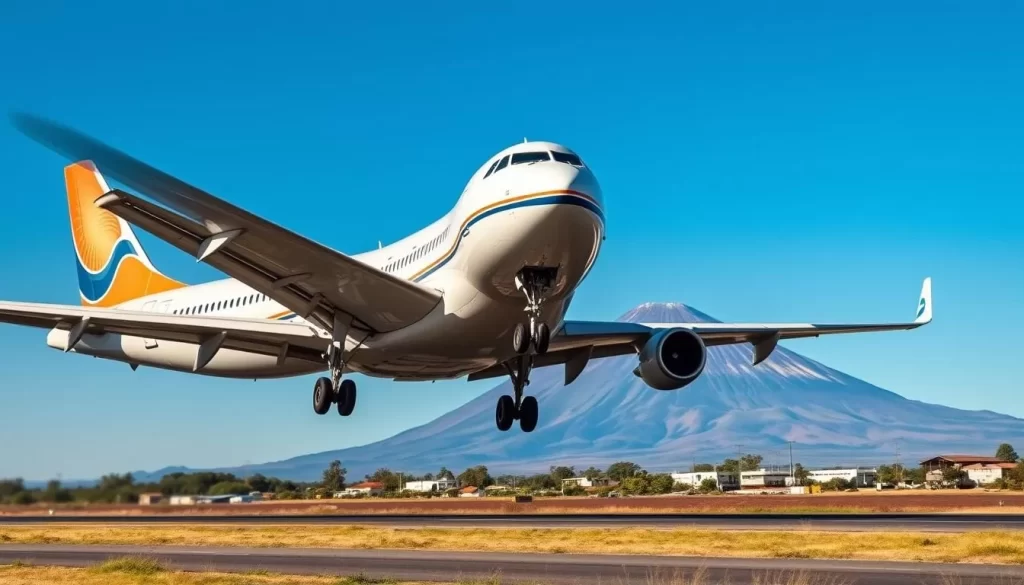
By Road: Driving to Lake Manyara
For those who prefer to drive or are looking for a more budget-friendly option, traveling by road is a viable alternative. From Kilimanjaro International Airport, it’s approximately a one-hour drive to Arusha, the gateway city for most northern Tanzania safaris. Once in Arusha, you can reach Lake Manyara National Park in about 90 minutes via a well-maintained highway that offers scenic views of the surrounding landscapes.
The road journey from Arusha to Lake Manyara National Park is relatively straightforward, making it suitable for those who enjoy driving or are traveling in a group. This option allows you to enjoy the picturesque views of the Tanzanian countryside and potentially spot some wildlife along the way.
Lake Manyara National Park Fees and Costs
To plan your visit to Lake Manyara National Park effectively, you need to be aware of the associated costs. The fees for entering the park are structured based on your age and residential status, making it essential to understand these categories to budget accordingly.
Entrance Fee Structure
The entrance fees to Lake Manyara National Park vary significantly based on your nationality and age. For foreign non-residents, adults are charged $59 per person per day, while children between the ages of 5 and 15 are charged $18 per person per day. If you’re a foreign resident, the fees are $30 per adult per day and $9 per child per day. Citizens of the East African Community pay the lowest rates, with adults paying approximately $5 per person per day and children $1 per person per day. It’s worth noting that minors under 5 years old are not charged.

Additional Costs to Consider
Besides the entrance fees, there are additional costs to consider when planning your visit to Lake Manyara National Park. If you plan to stay overnight within the park, you’ll need to factor in accommodation fees, which can range from $47.20 per night for foreign non-resident adults to $18 for children. Moreover, activities like night game drives, which are available at an extra cost, can enhance your experience but require additional budgeting. Remember, all payments for entrance fees must be made by credit card (Visa or Mastercard), as cash is not accepted.
When planning your visit, it’s also useful to consider the validity of your entrance fee. If you’re staying overnight, your entrance fee is valid for 24 hours, while day visitors’ fees are valid for a single entry during the park’s operating hours from 6 am to 6 pm.
Best Time to Visit Lake Manyara National Park
The best time to visit Lake Manyara National Park depends on your preferences and what you want to see. Whether you’re looking for ideal wildlife viewing or unique birdwatching opportunities, the timing of your visit is crucial.
Lake Manyara National Park is a year-round destination, offering different experiences throughout the year. Understanding the characteristics of each season will help you plan your trip accordingly.
Dry Season (June to October)
The dry season, spanning from June to October, is characterized by warm and sunny weather with little humidity. Temperatures range from 25°C to 32°C (77°F-90°F), creating comfortable safari conditions.
Wildlife viewing is generally easier during the dry months as animals concentrate around water sources and the thinner vegetation provides fewer hiding places. This increases your chances of spotting Lake Manyara’s famous tree-climbing lions.
Additionally, the dry season brings fewer mosquitoes, reducing the risk of malaria. With minimal rainfall, the roads within the park are generally accessible, making it an ideal time for game drives.
Wet Season (November to May)
The wet season, which includes the “Short Rains” (November-December) and “Long Rains” (March-May), offers a different set of experiences. April and May are typically the rainiest months.
The wet season is ideal for birdwatching, with the lake attracting thousands of pink flamingos between November and April. The lush vegetation and abundant water sources also make it a great time for spotting a variety of bird species.
Budget-conscious travelers may prefer the wet season, as safari prices tend to be lower. However, it’s essential to be prepared for afternoon rainfall and potential access difficulties in some areas.
Wildlife Highlights of Lake Manyara
With its diverse habitats, Lake Manyara National Park is a haven for a wide variety of wildlife, including some truly unique species. The park’s varied landscapes, from groundwater forests to acacia woodlands and grassy floodplains, support a rich array of animals, making it a prime destination for wildlife enthusiasts.
The Famous Tree-Climbing Lions
Lake Manyara National Park is most famous for its tree-climbing lions, a behavior that’s rare in the lion world. These lions have been observed lounging in the branches of acacia trees, a sight that’s both surprising and fascinating. While the exact reason for this behavior is still debated among experts, it’s believed to be related to factors like escaping the heat, avoiding biting insects, or simply enjoying a unique vantage point. Whatever the reason, witnessing these majestic creatures perched high above the ground is an unforgettable experience.
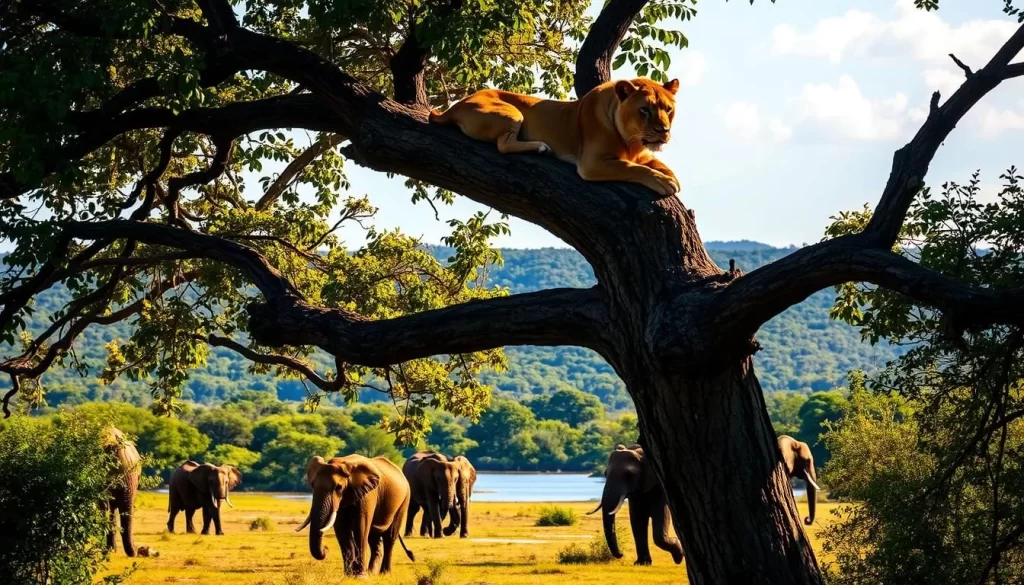
Other Mammals to Spot
Beyond the famous tree-climbing lions, Lake Manyara National Park is home to a diverse range of other mammals. You can expect to see:
- Elephants roaming through the forest and woodland areas.
- Giraffes gracefully browsing on acacia trees.
- Hippos wallowing in the lake’s waters.
- Zebras grazing on the grassy plains.
- Leopards, though elusive, can be spotted with a keen eye.
- Large troops of baboons, offering insights into their complex social structures.
The compact size of the park, combined with its diverse habitats, makes it an ideal location for spotting a wide variety of wildlife in a relatively short period. Whether you’re on a game drive or a guided walk, Lake Manyara National Park promises an enriching wildlife experience.
Birdwatching Paradise: Lake Manyara’s Avian Residents
With its diverse habitats, Lake Manyara National Park is a paradise for birdwatchers from around the world. The park is home to over 400 bird species, making it one of the most diverse birding spots on the continent.
The variety of habitats within the park, from the alkaline lake to the surrounding forests and grasslands, supports a wide range of avian life. This diversity is a key factor in making Lake Manyara National Park a must-visit destination for bird enthusiasts.
When and Where to See Flamingos
Lake Manyara is renowned for its large populations of pink flamingos. These elegant birds can be seen in large numbers between November and April, when the lake’s shallow waters provide ideal feeding grounds.
The flamingos are attracted to the lake’s alkaline waters, which are rich in algae, their primary food source. During the wet season, the lake’s water levels rise, creating an expansive habitat for these and other bird species.
| Month | Flamingo Population | Best Viewing Areas |
|---|---|---|
| November to April | Thousands | Lake shores and shallow waters |
| May to October | Fewer | Scattered throughout the lake |
Other Notable Bird Species
Beyond the flamingos, Lake Manyara National Park is home to a myriad of other bird species. Pelicans, herons, storks, and kingfishers are commonly seen around the lake, while the surrounding forests and woodlands host eagles, hawks, and a variety of smaller birds.
Some of the other notable species include:
- Crowned eagles and African hawk eagles
- White-winged widowbirds and yellow-billed kites
- Superb starlings and little bee-eaters
The wet season brings an influx of migratory species, further enriching the birdwatching experience. Visitors during this time can expect to see a significant increase in the diversity of birdlife throughout the park.
Top Things to Do in Lake Manyara National Park
With its rich biodiversity, Lake Manyara National Park provides a unique safari experience.
Game Drives: Morning, Afternoon, and Night
Game drives are an essential part of any safari experience at Lake Manyara National Park.
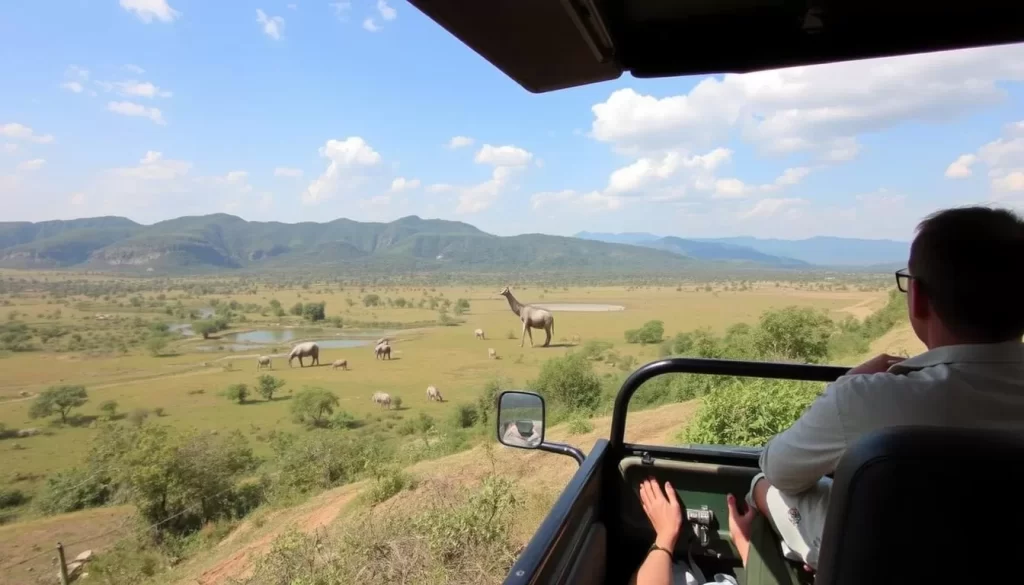
Early morning, mid-afternoon, and nighttime game drives offer unique animal encounters. The cooler early hours provide the best chances of spotting majestic wildlife, while evening drives allow you to see nocturnal creatures like civets, genets, and hunting lions.
Boat and Canoe Rides on the Lake
A boat or canoe ride on Lake Manyara offers a different perspective on the park’s diverse ecosystems.
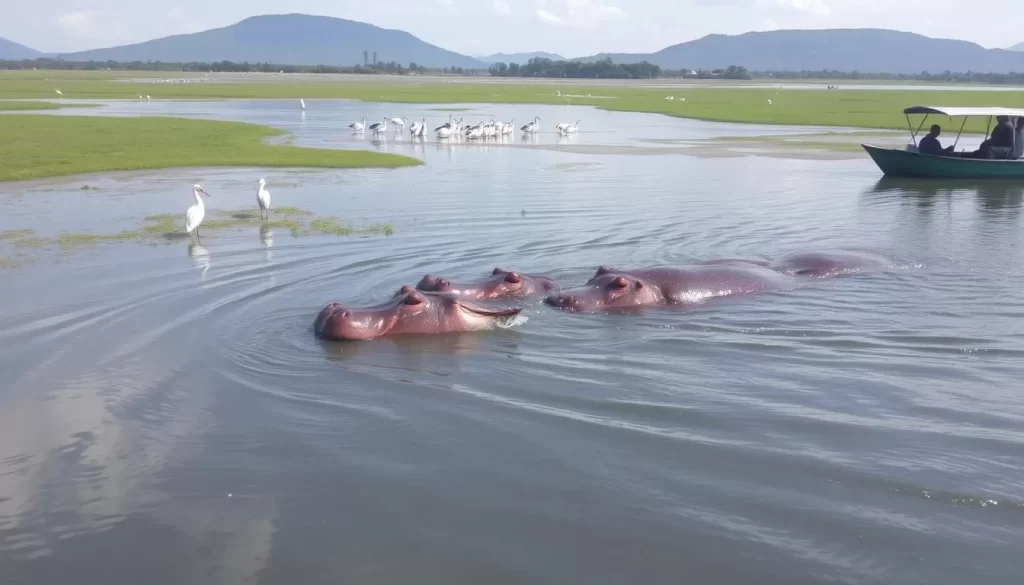
You can admire the park’s birds, including flamingos, pelicans, and herons, and might even find hippos bathing in the water, enjoying spectacular views of the Rift Valley escarpment.
Guided Nature Walks
Guided nature walks with an armed ranger allow you to experience the park’s smaller details.

You’ll venture into Lake Manyara National Park on foot, soaking up the scenery while keeping an eye out for wildlife such as monkeys and birds, and discovering tracks, plants, insects, and smaller wildlife.
The Treetop Walkway Experience
Elevate your safari experience with a walk among the trees on Lake Manyara’s treetop walkway. This 370-meter-long canopy walk is a thrilling way to explore the park from a new perspective.
What to Expect on the Canopy Walk
The canopy walk at Lake Manyara National Park is a secure suspension bridge with netting on either side, allowing you to meander 59 feet high among the treetops comfortably. You’ll enjoy a bird’s-eye view of the animals below and the birds at eye level, spotting monkeys, exotic birds, and even peaceful elephants and buffalos.
The walkway provides a unique perspective of the park, with eye-level encounters with birds and primates that inhabit the upper canopy. This offers exceptional photography opportunities and intimate wildlife observations not possible from the ground.
Best Time for the Treetop Adventure
The best time for your treetop adventure is early morning when the forest is alive with bird activity. The soft morning light filters through the canopy, creating a magical atmosphere enhanced by the chorus of birdsong. This is the ideal time to experience the full beauty of Lake Manyara National Park.
Visiting during this time allows you to observe the park’s wildlife in a serene and natural setting, making for a truly unforgettable experience.
Cultural Experiences Near Lake Manyara
Immerse yourself in the rich cultural heritage surrounding Lake Manyara National Park. A safari in this beautiful area is not just about the wildlife; it’s also an opportunity to engage with the local communities and learn about their traditions.
Visiting Maasai Villages
You can enhance your Lake Manyara experience by visiting nearby Maasai villages, where you’ll be welcomed by communities that have maintained their traditional way of life for centuries. During your visit, you’ll have the chance to learn about Maasai customs directly from community members.
- Learn about distinctive jumping dances and intricate beadwork.
- Gain insight into the importance of cattle in Maasai culture.
- Explore traditional Maasai homes (bomas) and their construction.
Local Traditions and Customs
The Manyara National Park area is rich in cultural heritage, with the Maasai people showcasing their unique traditions. You’ll have the opportunity to participate in traditional activities, sample local foods, and purchase authentic handcrafted souvenirs, supporting the community and helping preserve their cultural heritage.
- Experience the vibrant culture of the Maasai tribe.
- Learn about the sustainable use of natural resources.
- Engage with the local community and understand their way of life.
By visiting Lake Manyara National Park and engaging with the local Maasai communities, you’ll not only have a memorable experience but also contribute to the preservation of their cultural heritage. This unique cultural experience is a great way to complement your wildlife adventure in the park.
Unique Activities: Horseback Safaris and More
Beyond the typical safari experience, Lake Manyara National Park presents opportunities for horseback safaris and more. This unique way to explore the park offers a silent, immersive approach to wildlife viewing, allowing you to get closer to nature.
Horseback Riding Through the Park
Horseback riding is one of the most unique Lake Manyara activities. Horseback safaris are a magnificent and breathtaking way to observe the animals and landscapes. You’ll be able to access areas of the national park that are inaccessible to safari vehicles, opening up new territories for exploration and wildlife encounters.
Riding on horseback allows you to experience Lake Manyara National Park in a truly unique way. Many animals are less disturbed by horses than by vehicles, potentially allowing you to observe more natural behaviors during your horseback safari.
Other Specialized Safari Experiences
In addition to horseback safaris, Lake Manyara National Park offers other specialized experiences. Night game drives provide another unique experience, one of the few Tanzanian national parks that permits this activity. You’ll have the chance to spot nocturnal species like bush babies, civets, and hunting predators.
For photography enthusiasts, specialized photography safaris can be arranged with vehicles equipped with camera mounts and guides who understand the needs of photographers, enhancing your safari experience.
Where to Stay Near Lake Manyara National Park
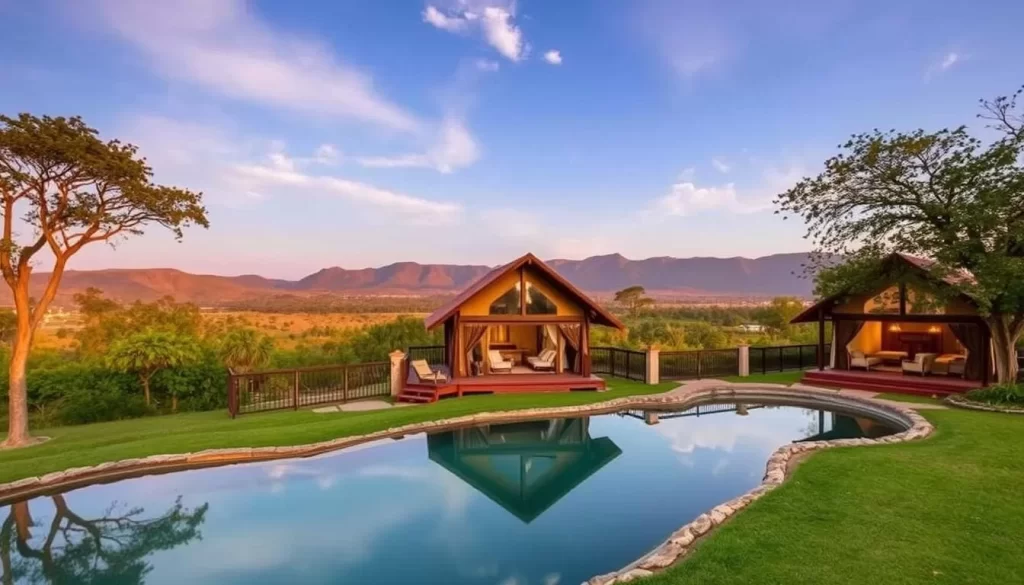
Selecting the perfect place to stay near Lake Manyara National Park can enhance your overall safari experience. The park offers a variety of accommodations to suit different tastes and budgets.
Luxury Lodges and Tented Camps
For those seeking a luxurious stay, there are several high-end lodges and tented camps near Lake Manyara National Park. These offer spectacular views overlooking the park and lake, along with amenities like infinity pools, gourmet dining, and spa services. Some lodges are perched on the Rift Valley escarpment, providing a breathtaking panorama. You can enjoy your stay in comfort, with some rooms even offering private balconies where you can watch wildlife.
Budget-Friendly Options
For travelers on a budget, there are comfortable guesthouses and hostels in the nearby town of Mto wa Mbu. This town not only offers affordable accommodations but also a chance to experience local culture, visit markets, and enjoy local cuisine. Many of these budget-friendly options are within a reasonable distance from the national park, making them convenient for your safari adventures.
Many accommodations, whether luxury or budget-friendly, can arrange special experiences like bush dinners, cultural visits, or specialized safari activities. It’s worth discussing your interests with your chosen property to enhance your Lake Manyara experience.
Planning Your Perfect Lake Manyara Safari Experience
With its diverse wildlife and breathtaking landscapes, Lake Manyara National Park is a highlight of any Tanzania safari. As part of the Northern Circuit, this park is often visited alongside the Serengeti, Tarangire, and the Ngorongoro Crater for a comprehensive wildlife adventure.
Lake Manyara National Park, despite its relatively small size of 325 square km, is home to four of the Big Five animals: lions, elephants, leopards, and buffalos. The park’s compact size makes it an ideal destination for a day visit or a longer, more leisurely exploration.
When planning your Lake Manyara safari experience, consider the timing of your visit. The dry season, from June to October, is ideal for optimal wildlife viewing, while the wet season, from November to May, is perfect for birdwatching, especially to see the famous flamingo flocks.
To make the most of your visit, allocate at least one full day to explore Manyara National Park. You can choose to work with a reputable tour operator who can customize your safari experience based on your interests, whether that’s photography, birdwatching, or spotting the famous tree-climbing lions.
Remember to pack appropriately for your Tanzania safari with neutral-colored clothing, binoculars, a good camera, sun protection, and any necessary medications. Preparing for variable weather conditions depending on the season of your visit will also enhance your experience.
In conclusion, Lake Manyara National Park offers a unique and unforgettable safari experience. By planning your visit according to your interests and working with experienced guides, you’ll be able to fully appreciate the park’s diverse wildlife and breathtaking landscapes.
The above is subject to change.
Check back often to TRAVEL.COM for the latest travel tips and deals.
